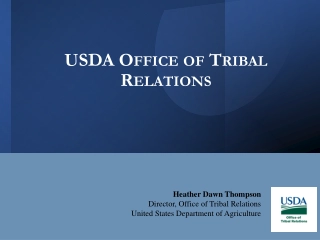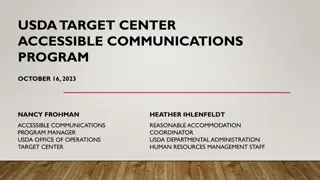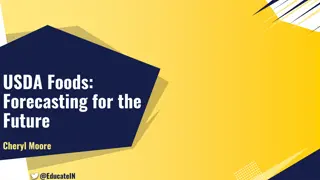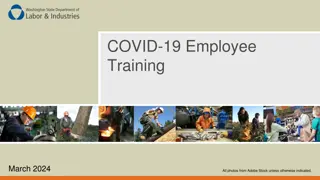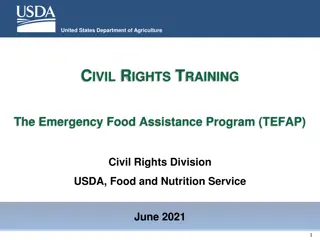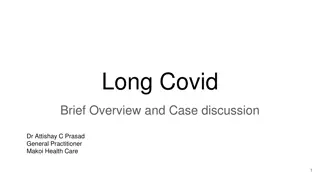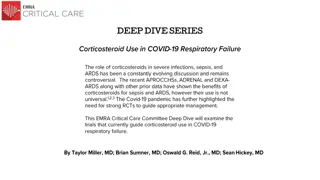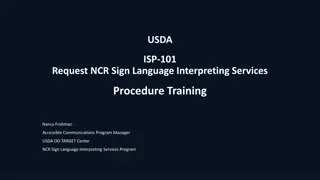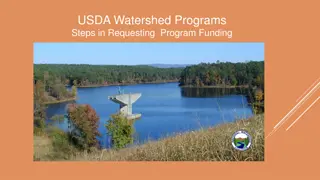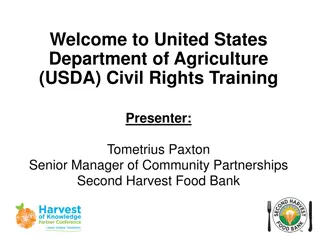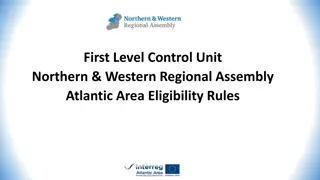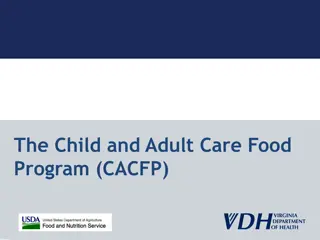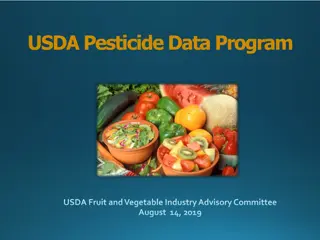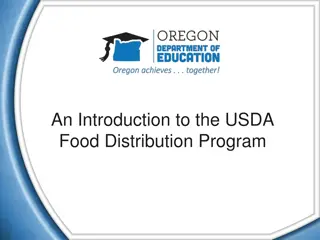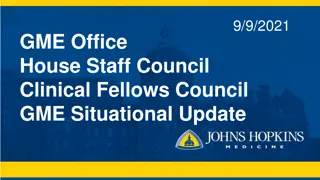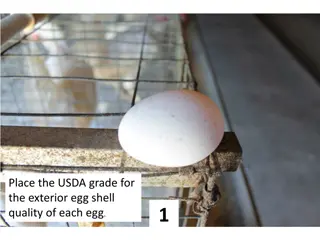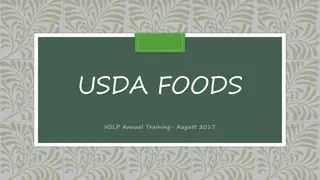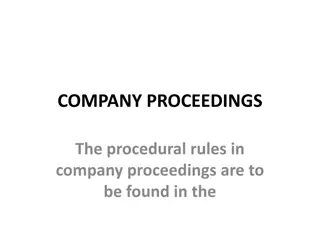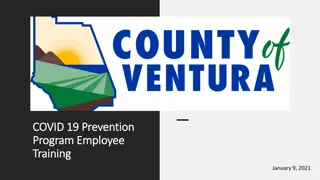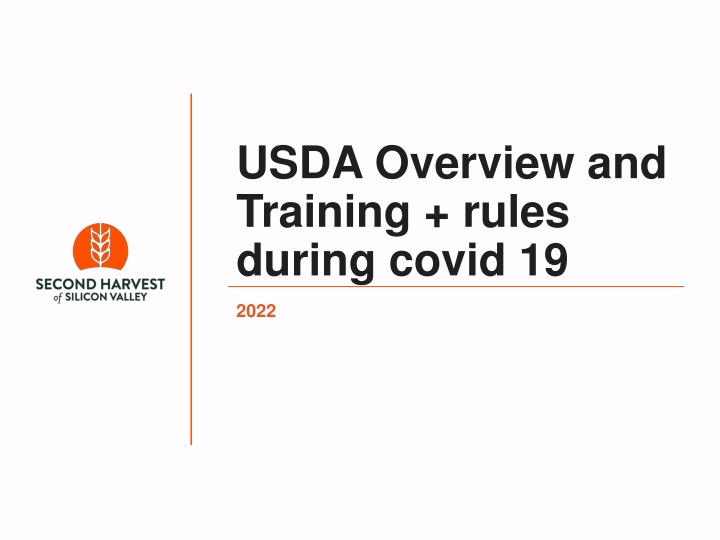
USDA Overview and Training Rules During COVID-19 2022 - Program Guidelines
Discover the USDA program overview and training rules during COVID-19, focusing on interim flexibility to prevent the spread of the virus. Learn about distribution types, guidelines for partners, and more. Stay informed and compliant with USDA agreements for effective program implementation.
Download Presentation

Please find below an Image/Link to download the presentation.
The content on the website is provided AS IS for your information and personal use only. It may not be sold, licensed, or shared on other websites without obtaining consent from the author. If you encounter any issues during the download, it is possible that the publisher has removed the file from their server.
You are allowed to download the files provided on this website for personal or commercial use, subject to the condition that they are used lawfully. All files are the property of their respective owners.
The content on the website is provided AS IS for your information and personal use only. It may not be sold, licensed, or shared on other websites without obtaining consent from the author.
E N D
Presentation Transcript
USDA Overview and Training + rules during covid 19 2022
*During covid 19 During covid 19, there are some interim flexibility to the rules. Until further notice, those waivers and guidance are provided to assist in the prevention of the spread of covid 19 by limiting exposure to staff/volunteers and clients. Those interim rule slides are titled with: *during covid 19 (like above) in this presentation. 2
Program Overview USDA = TEFAP/EFAP (The Emergency Food Assistance Program) Administered by the California Department of Social Services EFAP provides low income individuals and households with commodities provided by USDA Established to supplement the nutritional needs and not to satisfy all hunger needs or nutritional requirements of individuals/households 3
California Dept of Social Services (CDSS) Oversees at State level 48 Food Banks/58 Counties 1.1+ million people served monthly in California 4
USDA Agreement Must have signed agreement before starting program Outlines all requirements and procedures Each and every rule and procedure must be followed Second Harvest will lose contract for non- compliance 5
Distribution Types Two categories of distribution Household: provides groceries for home consumption (ex: pantries) Congregate meal: provides prepared meals on- site (ex: soup kitchens) 6
Distribution Guidelines As with all Second Harvest products, commodities cannot be sold or used as barter for services Distributing partner is accountable for any lost or damaged product. Report to your Second Harvest program manager immediately Report any misuse of commodities or any other pertinent information to your program manager. We may have to report to USDA Do not dispose of any USDA commodity without directions from a Second Harvest staff 7
Distribution Guidelines for Households Can serve unhoused clients. Use address of where they are staying or where car is parked Recipients must sign certification of eligilbity (EFA-7) each and every time Commodities are for home distribution only Submit USDA monthly report for unduplicated individuals and households served in that month 8
Distribution Guidelines for Congregate Meals Partners that provide meals to needy and/or unhoused individuals on a regular basis in a congregate setting Commodities are for congregate feeding only and cannot be given to participants to take from the premises. Please only order what is needed for the meal Submit USDA monthly report for unduplicated individuals and meals served in that month 9
Distribution Location and Schedule Must let Second Harvest know if you change distribution location or schedule Must have a posted schedule of distribution days and times at your site If all food is distributed before the advertised end time, a site representative must remain on site to inform recipients of their options (e.g. Provide Food Connection cards or let them know when to return again) 10
Storage Requirements All commodities must be stored 4-6 inches off of the floor and 4-6 inches away from the wall Frozen/refrigerated food must not be kept out for more than 2 hours at room temperature Food safety rule is within 4 hours. Food needs to return to the refrigerator or freezer or be prepared within that timeline. Food that is out for more than 4+ hours cannot be consumed safely 11
Verifying Eligibility Recipients income level must fall within 235% of the Federal poverty level Recipients are only required to self certify their income through their signature on the EFA-7 form Recipients may not be asked to supply proof of income 12
Calculating Monthly Reports Report the number of households that receive USDA food in addition to the regular reporting you already do Household participation numbers must reflect unduplicated individuals and households including those for distribution sites conducting more than one distribution per month. If your site conducts more than one distribution per month, any individual counts as one whether they get food once or multiple times in that month Congregate meal numbers must separately reflect the number of people and meals served. If one person has two meals, the report would reflect 1 person, 2 meals Report through our online link by the 7th of the month, every month All records must be kept for 3 years and the current year at your site and need to be available at your monitoring visits 13
Compliance Reviews/Audits USDA conducts compliance reviews of Second Harvest and distributing partners, on-site These compliance reviews may be unannounced Second Harvest will conduct our own compliance review of partners during monitoring visits USDA audits may include: Inspection of inventory and storage of commodities Audit of records and reports Review of procedures and methodologies 14
OMB and Audit Requirements Any organizations receiving USDA will need to fill out an OMB (Office of Management and Budget) Uniform Guidance Form at the end of the fiscal year Second Harvest will send that along with the annual valuation letter Any organization receiving $750,000 or more annually in Federal funds or food, either directly and/or as pass through (ie. from Second Harvest), must submit an audit report 15
Databases and electronic registration USDA is allowing partners to use any electronic database or tracking system of their choosing. This will still need to be approved by USDA but we can help advise and preview your selection. Your selection will need to have the information that is currently asked on the EFA-7 and able to replicate an electronic report. For Second Harvest-run grocery programs, we are currently capturing client info in Salesforce. 16
Mandatory Forms and Posted Information 2021 17
Required Signage at Sites Must be posted in clear view of all recipients at each distribution: Income guidelines EFA-7 sign in sheet And Justice for All Poster For religious organizations, The Emergency Food Assistance Program (TEFAP) Written Notice of Beneficiary Rights 18
Income Guidelines Income must be within the 235% poverty level guidelines (for complete chart, see handout) Household Size Annual Income Monthly Income 1 $31,937 $2,661 2 $43,029 $3,586 3 $54,121 $4,510 4 $65,213 $3,434 19
Sign In Sheet (EFA-7) All participants must sign the form and answer all questions on form Exempt for congregate meal programs Anyone unable to write their name, may mark the letter X on the signature line. A distribution volunteer must then initial their own name and print the recipient s name next to the X Site must collect and maintain forms for 3 years plus current year Second Harvest and USDA auditors may ask to see originals 20
*During covid 19 USDA sites still need to use the EFA7 sign in sheets, however Site volunteer or staff may sign for the client and note covid 19 in the signature box Site volunteer/staff would put a check mark on the EFA7 for client in address Allow client to see their name and address has been checked off See sample on next slide 22
Alternate Pick Up Forms An alternate person may pick up commodities for a recipient in their absence Alternate must bring with them an Alternate Pick Up form signed by the eligible recipient to an authorized pick up the first time and then be certified annually The alternate must write the recipient s name as well as their own name on the EFA-7 If an alternate does not bring the Alternate Pick Up form to the site, a note from the recipient authorizing the pick up will suffice Alternate pick up forms and notes must be maintained on file and recertified or a new one filled out, annually It is recommended the alternate pick ups be trackable (ie. The person that came for pick up is recorded or a list of eligible alternates be readily available for verification) Limit of 5 alternate pick up forms may be presented at one time by one alternate chosen to pick up commodities (translation: only one person can pick up for five) 24
Alternate Pick Up note The note must include: Date Statement authorizing the pick up by the alternate Alternate s name Statement that the recipient is income eligible Recipient s signature, address, and household size 25
Sample Alternate Pick Up Form 26
*During covid 19 Removed the requirement for a new alternate pick up note for each distribution Have one note for each alternate on file is enough, don t need to bring a new form each time Removed limitation of 5 alternate pick up forms being presented at one time One alternate can pick up for as many people as needed 27
*During covid 19 Alternate pick up sites may be used as necessary Site must contact and receive permission from client for this alternate service Alternate may then sign on behalf of client and write covid 19 28
And Justice for All Poster This will inform recipients of their civil rights, and right to file or make a verbal complaint including an anonymous complaint 29
Religious Organizations The Emergency Food Assistance Program (TEFAP) Written Notice of Beneficiary Rights must be posted Provides written notice to recipients of the right to be referred to an alternate provider when available 30
Forms and Resources Forms and resources can be found here: General forms--all EFA7 sign in sheet Alternate pick up form Income guidelines Bookmark these links! 32
Civil Rights 2022 33
What are Civil Rights? Civil Rights are the rights of an individual to receive equal treatment (and to be free from unfair treatment or discrimination) based on certain legally protected classes 34
Civil Rights Training In accordance with the Federal law and USDA policy, there must be no discrimination in the distribution of USDA commodities under this part because of race, color, national origin, sex, age, or handicap All distributing partners must take an annual civil rights training for all staff delivering services All distributing partners must provide an annual civil rights training for all volunteers Training must first occur at orientation prior to any contact with clients or their personal information Copy of the checklist (FDU 113) must be kept on file as proof of completion for three years plus the current year 35
Who needs training? Program management staff at any distribution site Lead program/site volunteers or staff Individuals who interact with clients, determine eligilbity, handle confidential client information 36
Instructions for Civil Rights Training Level 1 Training Checklist (FDU 113) Program management staff at any location and lead program volunteers. This includes all individuals who interact with clients, determine eligibility, or handle confidential client information. Level 2 Civil Rights Presentation; in addition to the checklist The following individuals must also complete a second level of training which shall be completed by viewing the FDU Civil Rights Presentation. Program management staff at any location and lead program volunteers. **Program management staff and lead program volunteers will need to do both levels. ** 37
Civil Rights Training Tools Civil rights annual training checklist (FDU 113) Civil rights annual training checklist (FDU 113) Spanish Civil rights training PPT presentation Civil rights general resources Civil rights complaint form 39
Summary of Next Steps To qualify for USDA, we need from you: USDA agreement Take/view civil rights training Provide civil rights training to staff/volunteers 40
Contact compliance team Luz Ayala, Compliance Manager layala@shfb.org 408 266-8866 ext 267 Ed Aldeo, Compliance Coordinator ealdeo@shfb.org 408 266-8866 ext 253 41

